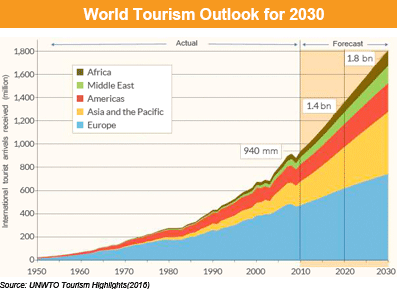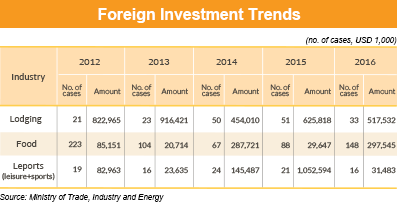

The tourism and leisure industry provides tourist services relat-
ed to transportation, accommodation, dining, sports, entertain-
ment, vacationing, tourism and the operation of tourist facilities.
More than any other industry in Korea, the tourism and leisure
industry has been effective in creating revenue, employment and
added value, significantly contributing to national economic
development.
According to the United Nations World Tourism Organization
(UNWTO), international tourist arrivals grew by 4.6 percent
worldwide in 2015, reaching a record-breaking 1.19 billion
arrivals, after topping the 1 billion mark in 2012. Globally, Korea
ranked 23rd in the number of foreign tourists.
In 2015, the number of domestic tourists in Korea increased 0.7
percent from the previous year to 38.31 million. In the same year,
the number of foreign tourists to Korea reached 13.23 million,
down 6.8 percent from 2014. This was largely due to the outbreak
of the Middle East Respiratory Syndrome (MERS) in May.

As to reasons why tourists visited Korea, traveling for “leisure,
recreation and vacationing” accounted for the
largest share in
2015, followed by “business and professional” reasons, “shopping” and “visiting friends and relatives”.
Meanwhile, because the tourism market is an industry of
final
demand, the demand for tourism is considered a direct indication
of future growth. The number of international tourists worldwide
is expected to steadily increase, reaching 1.4 billion in 2020, and
1.8 billion in 2030.
From 2010 to 2030, tourists are expected to grow at an average
annual rate of 3.3 percent worldwide, and at a higher rate of 4.9
percent in Northeast Asia.
A marina is an area on a coast with mooring docks and subsidiary facilities for leisure boats, providing services for a variety
of marine leisure activities. Unlike many advanced countries
with highly developed marine leisure cultures based on established marina facilities, Korea is still in the early stages of marina
development.
Korea currently has six marinas, and plans to open 58 new
marinas by 2019. To vitalize the marine leisure equipment industry, the Ministry of Knowledge Economy established a plan in
2010 to develop leisure ships, produce finished products and
parts and build a foundation to facilitate their supply. This plan
aims to contribute to the country’s efforts to open marina facilities and develop relevant service businesses.
To prepare for the increase in future national income driving
up the demand for marinas, the Korean government established a
plan to build marina ports in 2015, and has since been actively
working on its implementation.
Resorts
Resorts are business establishments that provide tourists with a
variety of facilities suitable for sports, entertain-
ment, dining and recreational activities. Through the Third Tourism Development
Basic Plan (2012-2021), Korea’s tourism ministry has designated
tourism belts for areas
along the eastern, western and southern
coasts, the Korean Penninsula Peace Ecotourism Belt
along the northern
border, the Riverside Eco-Culture Tourism
Belt for the tourist areas with inland rivers and waterside
environments and the Baekdudaegan Ecological Culture Tourism
Belt, taking advantage of the natural and cultural
resources of the
Baekdudaegan mountain range.
Theme Parks
According to TEA/AECOM’s annual Global Attractions
Attendance Report, about 235.6 million visitors attended the top
25 theme parks in the world in 2015. Magic Kingdom at the
Walt Disney World Resort in Lake Buena Vista, Florida, ranked
first in the world, with about 20 million visitors in 2015. In
Korea, Everland and Lotte World respectively were ranked 14th
and 16th place.
The recent trend toward high-tech theme parks is increasing
the adoption of cutting-edge communication, IT, robot and other
technologies in the industry. High-tech theme parks differ from
general theme parks in that the main focus is on the advanced
technologies, such as virtual reality, simulation and hologram
technologies. Examples of high-tech theme parks overseas
include Epcot (Florida, USA), Space World (Kitakyushu, Japan)
and Joypolis (Yokohama, Japan).
Success in the digital entertainment industry, which aims to
entertain through technology, relies heavily on how well quality
cultural content can be integrated with cutting-edge technologies.
Moreover, when the industry has a stable foothold in local communities, establishing a steady supply of human and technological
resources, they can create synergy with high-tech theme parks.
The biggest amount of foreign direct investment made in tourism-related industries in 2016 was the USD 517 million spent in the lodging industry, followed by USD 297 million in the food industry and USD 31 million in the leisure and sports industry. While foreign direct investment in tourism-related industries tends to fluctuate each year, the lodging industry continues to attract the greatest amount. Meanwhile, two of Korea's most hightly anticipated tourism districts are Saemangeum District and Taean Tourism and Leisure City.

Saemangeum District
Upon completion of the Saemangeum Seawall and in compliance with the Comprehensive Saemangeum Development Plan,
the Saemangeum Tourism Complex is being developed into a
world-class hub for the tourism and
leisure industry on the western coast. The district will be comprised of sections that focus on
tourism and leisure, international cooperation and industrial
research. The project plans to connect the locational merits of
Saemangeum with the surrounding natural landscape, including
Byeonsanbando National Park and Gogunsan Islands, thereby
allowing visitors of all ages to enjoy this region all year around.
Taean Tourism and Leisure City
When complete, Taean Tourism and Leisure City will be
equipped with a wide range of facilities such as golf courses,
fairway villages, theme parks and international business complexes. As such, tourists will be able to enjoy sightseeing, leisure
activities and entertainment all in one place. Most notably, the
city’s high-tech complex will focus on fostering bio-agriculture and
biotechnology.
To improve the international competitiveness of Korea’s
tourism industry, the ministry is focusing its efforts to nurture
high added-value tourism businesses in Korea. To develop the
strategic convergence industries of cruise tourism, MICE (meetings, incentives, conferences and exhibitions) tourism and medical tourism, the ministry has strived to provide greater support
and improve various institutional conditions.
The tourism ministry has also pushed forward with various
policies to attract more tourists to regional locations and create a
stronger foundation for local tourism. To develop traditional cultural content into the representative tourist products, it has strived
to search the country for traditional cultural resources that have
potential to be recreated into quality tourist products.
In 2015, the ministry completed the selection of 10 themes for
the industry, including historical sites, culture of Joseon-era
scholars (memorial halls for Confucian services and old houses),
traditional lifestyles (Korean medicine, traditional houses,
clothes and pottery) and stories (folktales and characters), and is
currently engaged in developing related tourist products to
attract a growing number of foreigners.